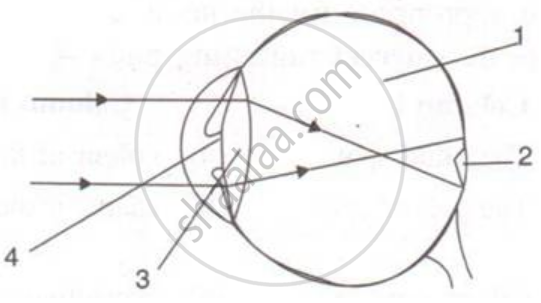Advertisements
Advertisements
Question
Differentiate between:
Short-sightedness and Long-sightedness.
Solution
| Short-Sightedness | Long-Sightedness |
| (i) The inability of the eye lens to focus images of distant objects on the retina; so the images fall in front of the retina. | The inability of the eye lens to focus near object images on the retina; so the images fall beyond the retina. |
| (ii) It is corrected by using glasses of a concave lens. | It is corrected by using glasses of a convex lenses. |
APPEARS IN
RELATED QUESTIONS
In a Std. X class out of 40 students 10 students use spectacles, 2 students have positive power and 8 students have negative power of lenses in their spectacles.
Answer the following questions:
(1) What does the negative power indicate?
(2) What does the positive power indicate?
(3) Generally which type of spectacles do most of the students use?
(4) What defect of eyesight do most of the students suffer from?
(5) Give two possible reasons for the above defect.
List three common refractive defects of vision. Suggest the way of correcting these defects.
Name one defect of vision (or eye) which cannot be corrected by any type of spectacle lenses.
A man can read the number of a distant but clearly but he finds difficulty in reading a book.
From which defect of the eye is he suffering?
The near point of a long-sighted person is 50 cm from the eye.
(a) Can she see clearly an object at:
(i) a distance of 20 cm?
(ii) at infinity?
Differentiate between members of the following pair with reference to what is asked in the bracket.
Rods and cones (sensitivity).
What is meant by optical illusion? Give one example.
Observer the following diagram and answer the questions.
a) Which eye defect is shown in this diagram?
b) What are the possible reasons for this eye defect?
c) How this defect is corrected, write it in brief?

State the main functions of the following:
Tears
Write whether the following is true or false:
A convex lens is used for correcting myopia.
Given below is a diagram depicting a defect of the human eye? Study the same and answer the question that follow:

Name the parts labeled 1 to 4.
Given below is a diagram depicting a defect of the human eye? Study the same and answer the question that follow:

Draw a labeled diagram to show how the above mentioned defect is rectified using the lens named above.
Solve the following question:
The near point of the eye of a person is 50 cm. Find the nature and power of the corrective lens required by the person to enable him to see clearly the objects placed at 25 cm from the eye?
In what two whys is a yellow spot different from the blind spot?
Name the common defects of the eye.
Explain the Term: Hypermetropia
Explain the Term: Cataract
Observe the figure and answer the following questions:

- Name the defect of vision represented in the above figure.
- State the reasons for this defect.
- How is it corrected?
- Draw the diagram to show the correction of this defect.
Match the following:
| Column - I | Column - II |
| 1. Retina | a. Path way of light |
| 2. Pupil | b. Far point comes closer |
| 3. Ciliary muscles | c. near point moves away |
| 4. Myopia | d. Screen of the eye |
| 5. Hypermetropia | e. Power of accommodation |
